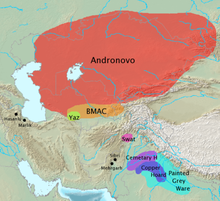
Back Yaz-Kultur German Cultura yaz Spanish فرهنگ یاز Persian Kebudayaan Yaz ID Cultura di Yaz Italian Jazo kultūra Lithuanian Jazcultuur Dutch Yazkulturen NB Язская культура Russian யாஸ் பண்பாடு Tamil
 Archaeological cultures associated with Indo-Iranian migrations (after EIEC). The Andronovo, BMAC and Yaz cultures have often been associated with Indo-Iranian migrations. The GGC (Swat), Cemetery H, Copper Hoard and PGW cultures are candidates for cultures associated with Indo-Aryan migrations. | |
| Period | Early Iron Age c. 1500–500 BC or c. 1500–330 BC |
|---|---|
| Type site | Yaz-Tappe, Yaz Tepe, or Yaz Depe, near Baýramaly, Turkmenistan |
| Preceded by | |
| Followed by | |
The Yaz culture (named after the type site Yaz-Tappe, Yaz Tepe, or Yaz Depe, near Baýramaly, Turkmenistan[1]) was an early Iron Age culture of Margiana, Bactria and Sogdia (c. 1500–500 BC,[2][3][4][5][6][7][8] or c. 1500–330 BC[9][10]). It emerges at the top of late Bronze Age sites (BMAC), sometimes as mud-brick platforms and sizeable houses associated with irrigation systems. Ceramics were mostly hand-made, but there was increasing use of wheel-thrown ware. Bronze and iron arrowheads, also iron sickles and carpet knives among other artifacts have been found.[11][12][13]
With the farming citadels and absence of burials it has been regarded as a likely archaeological reflection of early East Iranian culture as described in the Avesta.[14][15] So far, no burials related to the culture have been found, and this is taken as possible evidence of the Zoroastrian practice of exposure or sky burial.[2][16][17][18]
- ^ "Yaz Tepe". Brill Reference. Koninklijke Brill NV. October 2006. Retrieved 1 October 2016.
- ^ a b Parpola 1995, p. 372.
- ^ Mallory & Adams 1997, p. 653.
- ^ Kuzmina 2007, p. 416–417, 426–428, 431, 157, 449–450:V. Sarianidi and G. Gutlyev in the 1970s and 1980s suggested a date at the end of the 2nd millennium BC. Elena Efimovna Kuzmina considered that some Yaz I sites belonged to the 10th-9th centuries BC, while the cultural synthesis at the border of the 2nd/1st millennium BC, circa 1000–800 BC. Vasily Abaev considered the nomads to be related to the Scythians or Saka, which relates to the Yasht 13.143 "the territory of Arya... Turya, Sairima, Daha".
- ^ Buławka 2009–2010, p. 121.
- ^ Raffaele Biscione; Ali Vahdati (2012). "The Iranian-Italian archaeological mission: Season 2012: The identification of cultural areas" (PDF). Studi Micenei ed Egeo-Anatolici. 54. Edizioni dell'Ateneo & Bizzari: 358.
- ^ Boroffka & Sverchkov 2013, p. 49.
- ^ Parpola 2015, p. 298.
- ^ Cite error: The named reference
Lhuillierwas invoked but never defined (see the help page). - ^ Bendezu Sarmiento, Julio, Philippe Marquis, Johanna Lhuillier, and Hervé Monchot, (2018). "A sepulchral pit from the Late Iron Age in Bactra: The site of Tepe Zargaran (Afghanistan)", in: Johanna Lhuillier and Nikolaus Boroffka (eds.), A Millennium of History, Deutsches Archäologisches Institut, Berlin, p. 319: "...In southern Central Asia, the Iron Age saw the almost-complete disappearance of burial (Sine Sepulchro period covering the Yaz I-III sequence, ca. 1500-330 BCE)..."
- ^ Mallory & Adams 1997, p. 653–654.
- ^ Kuzmina 2007, p. 430.
- ^ Khlopina 2015, p. 55.
- ^ Mallory & Adams 1997, p. 310–311.
- ^ Kuzmina 2007, p. 444.
- ^ Mallory & Adams 1997, p. 311.
- ^ Bendezu-Sarmiento & Lhuillier 2013, p. 282.
- ^ Parpola 2015, p. 103, 106, 298.